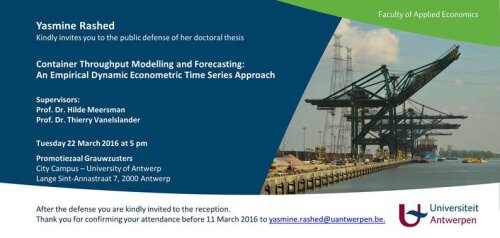Container throughput modelling and forecasting: an empirical dynamic econometric time series approach - Yasmine Rashed

Port policy makers rely on demand traffic forecasts to support the decisions related to operation and future port infrastructure investments. It is a challenge to match capacity to demand. On the one hand, they face the risk of costly excess capacity, and on the other hand, under-capacity causes loss of market share.
In addition, the volatility and uncertainty of the global economy, and, consequently, of the maritime trade and port sector impose a challenge to modelling and forecasting container throughput. The main research question of this thesis is which model to use to forecast the container throughput at the port level?
The aim of the thesis is to provide an instrument to support stakeholders in making short-term operational decisions and long-term planning and investment decisions to cope with the uncertainty of the future demand. This is achieved by developing quantitative models using a time series approach that analyses, identifies and quantifies the relationship between economic activity and container throughput at the port level.
Forecasting the number of TEUs at the port level in the short-term assists in the planning of the operational decisions such as the port capacity utilisation, loading and unloading planning, handling of containers and hinterland connections capacity. In comparison, the long-term forecasting is useful to assess the future infrastructure investment decisions. Application to other ports is feasible taking into account the specific characteristic of each port’s location and the country’s macroeconomic indicators.
Throughout the thesis, the analysis incorporates the 2008 financial crisis in the modelling process, which has the advantage of providing insight into the data generating process and the impact of the crisis. Moreover, the analysis identifies leading indicators with time lag that enable improving the monthly container throughput forecast. Combining different scenarios and the ARDL model provides reliable long term forecasts.
The findings show that for the short-term, the EU18 industrial confidence indicator and the index of industrial production are leading the container throughput at the Port of Antwerp. For the long-term, the elasticity of the container throughput in the Hamburg-Le Havre range to trade indices is about 1.4 on average.
Valentin Carlan: 'Maritieme supply chain innovation: costs, benefits ans cost-effectiveness of ICT introduction
Maritime supply chain innovation: costs, benefits and cost-effectiveness of ICT introduction
ICT innovation has become a key prerequisite for maritime supply chain (MarSC) stakeholders to remain competitive. In this context, new technological advancements from early EDI-based (electronic data interchange) solutions to contemporary blockchain-based tools are continuously changing the market. The MarSC actors need to decide which ICT solution to implement. In this process, own financial benefits are key. Equally so, the broader effects on other stakeholders participating in the chain are relevant. However, there is no comprehensive framework available to identify the costs and benefits of ICT innovation in the MarSC reported in the literature, nor applications that calculate their cost-effectiveness.
Phd Valentin Carlan